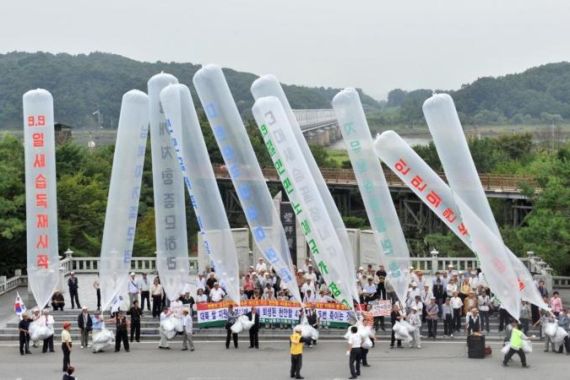Korean propaganda soars with balloons
Helium balloons carry millions of messages of hope and hate across Korea’s heavily guarded Demilitarized Zone each year.

Imjingak, South Korea – One could say propaganda is ballooning on the Korean Peninsula.
At the Demilitarized Zone (DMZ) – the world’s most heavily fortified border – North Korean defector Lee Ju-seong organises the launch of six large, helium-filled balloons loaded with “good-will” messages that will float back into the country he escaped from.
Millions of messages are delivered on thousands of balloons this way each year across the DMZ.
The balloons soar from the South deep into the impoverished North, where they crash to the ground, dispersing what some call messages of hope, and others deem propaganda.
While living in North Korea, Lee was inspired by a similar balloon drop with a message that urged him to flee the communist state in 2006.
“When I came to the South and saw how rich it was, I was very angry at the Pyongyang regime and decided to try to bring change to the North through the ballooning campaign,” says Lee.
North and South Korea are still technically at war since the 1950-53 Korean War ended in an armistice, rather than a peace treaty. While the South prospers with Asia’s fourth-largest economy, North Korea’s 25 million people flounder in poverty and hunger.
|
“One pair of South Korean-made socks could sell on the North’s black market for enough corn to feed a North Korean child for two months.“ – Lee Ju-seong, North Korean defector |
Soaring socks
During a launch on September 15, Lee and his team headed to Imjingak, a DMZ-area tourist park, to float messages ahead of the Chuseok holiday, Korea’s Thanksgiving.
“Brothers and sisters: We haven’t forgotten about your suffering,” read one.
“Until unification, please stay alive. People around the world love you,” said another.
Along with the good-will leaflets, the Koreans also sent socks, which are “as necessary as food in North Korea”, Lee explains.
He has ballooned good-will leaflets for the past six years. But the socks are a relatively new payload.
“There’s a dire shortage of socks in the North’s countryside, resulting in frostbite and gangrene in cold weather that can lead to the loss of one or both feet,” the defector says. “One pair of South Korean-made socks could sell on the North’s black market for enough corn to feed a North Korean child for two months.”
North Korean defector Park Sang-hak is one of the founding fathers of the balloon-propaganda movement. He floats leaflets highlighting the regime’s abuses – a harsh reality carefully hidden from the isolated public.
Park’s group sends an average of five million propaganda leaflets into North Korea every year, along with cash and DVDs.
So effective are his efforts that he’s received threats of North Korean military strikes against his launch sites along the DMZ. When that failed to deter Park, Pyongyang reportedly sent a secret agent to kill him.
The spy was caught by South Korean authorities with a poisoned needle at a subway station where he planned to assassinate Park.
The other main player in the balloon movement is Lee Min-bok, who sends pro-Christian leaflets to the North, along with searing anti-regime sentiments. Lee’s group also floats over money, small radios, noodles and medicine.
He launches about 1,500 balloons a year, a number he plans to double.
 |
|
Anti-North Korea leaflets released from balloons [Reuters] |
Not all South Koreans support the practice. Opponents say it causes the North’s military to open fire on the balloons, which could spark a conflagration, as well as leading to civilian deaths from wayward artillery shells.
The North strikes back
In his late 20s, Kim Jong Un became North Korea’s supreme leader in December 2011 after the death of his father, Kim Jong Il. But relations have yet to improve between the South and North under one of the world’s youngest leaders.
Some analysts say inter-Korean relations have worsened since his takeover.
It remains to be seen whether ties will improve once South Korea’s conservative President Lee Myung-bank – who has taken a hardline approach with Pyongyang – steps down early next year. A new South Korean president will be chosen in a December election.
“The North Koreans have intensified their attacks on Lee Myung-bak’s administration under Kim Jong Un,” says Scott Snyder, a senior fellow for Korean studies at the Council on Foreign Relations.
After a 12-year hiatus, North Korea hit back in the balloon-propaganda war in July, sending 16,000 leaflets into the South. One warned of war on the Korean Peninsula if Seoul overlooked the “big terror” – a possible reference to its sworn enemy the United States.
The two Koreas had agreed to stop psychological warfare against each other at a landmark meeting in 2000. Seoul banned the balloon launches, but rescinded after a March 2010 torpedo attack on a South Korean warship killed 46 sailors.
|
“The US and the South Korean regime are vicious bellicose forces disturbing peace and stability on the Korean Peninsula and bringing the danger of a nuclear war.“ – Korean Central News Agency |
Pyongyang’s main propaganda weapon is the state-run Korean Central News Agency, which pulls no punches in its colourfully worded reportage.
A September 24 article, for example, blasted the “South Korean puppet brass hats and their American masters” over joint military exercises.
“The US and the South Korean regime are vicious bellicose forces disturbing peace and stability on the Korean Peninsula and bringing the danger of a nuclear war,” KCNA reported.
From air to airwaves
Both countries have in the past set up large speaker systems along the DMZ to blare messages at each other. The North threatened to attack the speakers with artillery after the South set up dozens in 2010.
Radio waves are also employed in the game of psychological warfare. Two independent stations in South Korea – Open Radio North Korea and Radio Free North Korea – target North Korean listeners.
The stations say paid informants inside the communist country communicate “news” using Chinese-made mobile phones that is later broadcast.
“Run on shoestring budgets by North Korean defectors and South Korean and Japanese activists, these groups walk a line between journalism and advocacy,” writes Robert Boynton in The Atlantic magazine.
Owning a radio in North Korea is an offence punishable by death.
Conversely, South Korea blocks access to North Korean broadcasts and websites. Long jail terms can be imposed under its harsh National Security Law for possessing pro-North Korean material.
South Korea’s supreme court upheld a two-year sentence for a woman convicted of possessing music with titles that praised the North Korean regime in November 2010. It ruled the songs contained “enemy-benefiting” expressions that threatened the country’s security.